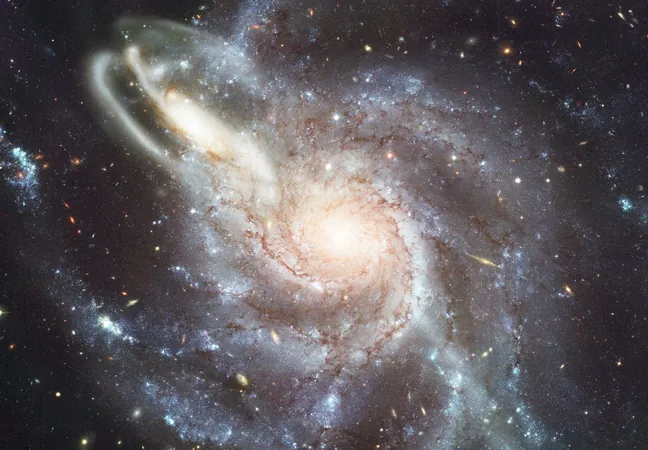
Asteroid Bennu: A Cosmic Time Capsule Packed with Stardust Older than the Solar System
2025-08-26
Author: Wei
NASA's Groundbreaking Discovery from Bennu
In a remarkable achievement, NASA's OSIRIS-REx mission has retrieved samples from the asteroid Bennu, a colossal space rock roughly 1,600 feet in diameter. After seven years of exploration, the mission has brought back ancient rock and soil that predate Earth itself!
But these aren't just any samples; they contain a cosmic narrative stretching back billions of years, etched in dust from long-gone stars and minerals shaped by water—making them key to unlocking the mysteries of our solar system's origins.
The Intriguing Origins of Asteroid Bennu
Bennu's formation story is a jigsaw puzzle of fragments from a vastly older parent asteroid that once orbited between Mars and Jupiter. This original body was a melting pot of materials from across the early solar system, comprising elements formed near the Sun, beyond the giant planets, and even beyond our solar system itself.
The tantalizing mix of components suggests that Bennu's parent body originated in the frigid outer solar system, possibly far beyond Jupiter and Saturn, before being shattered in a cataclysmic collision.
Unveiling Cosmic Stardust and Organic Mysteries
Scientists analyzing the Bennu samples have uncovered a treasure trove of stardust—tiny grains that are remnants from stars that existed long before our solar system took shape. Thanks to their unique isotopic signatures, these rare particles provide insights that are nearly impossible to find on Earth.
According to Jessica Barnes, an associate professor at the University of Arizona, these grains not only tell the tale of dead stars but also hint at organic compounds formed in the depths of interstellar space. The samples reveal a fascinating mixture of materials from different cosmic environments.
Bennu's Ancient History of Water
The studies also indicate that Bennu once had water, or at least its parent body did. Researchers found evidence of minerals that underwent chemical changes due to contact with liquid water, likely occurring at a cozy 77°F (25°C)—similar to room temperature on Earth.
Tom Zega, co-lead of the study, suggests that Bennu’s parent body may have accumulated icy materials from the outer solar system that melted over time due to residual heat or radioactive decay. This melting scenario essentially set the stage for complex chemistry that may have contributed to the building blocks of life itself.
Bennu: A Survivor of Cosmic Weathering
But Bennu’s journey didn’t end with its formation. The asteroid's surface bears the marks of constant bombardment by micrometeorites and solar winds—events collectively known as space weathering. This relentless exposure has altered its surface materials, presenting challenges for telescopic observations.
The Significance of the OSIRIS-REx Samples
While many meteorites perish upon entering the Earth's atmosphere or become contaminated over time, the pristine samples collected by the OSIRIS-REx mission provide a unique opportunity for scientists. Each untouched grain is a snapshot of the solar system's early chemistries, crucial for unraveling the origins of our planet.
Bennu: More Than Just a Space Rock
Despite its appearance as a mere rubble pile in space, Bennu is essentially a cosmic time capsule. It encapsulates a grand narrative of our solar system's infancy, bearing not just the echoes of ancient stars, but also the signatures of water—a vital ingredient for life—and the scars of its tumultuous past.
As scientists sift through these samples, they inch closer to answering profound questions about our own origins and the conditions that may have sparked the first inklings of life.
Image credit: NASA/Goddard/University of Arizona. The full study is published in the journal 'Nature Astronomy.'


 Brasil (PT)
Brasil (PT)
 Canada (EN)
Canada (EN)
 Chile (ES)
Chile (ES)
 Česko (CS)
Česko (CS)
 대한민국 (KO)
대한민국 (KO)
 España (ES)
España (ES)
 France (FR)
France (FR)
 Hong Kong (EN)
Hong Kong (EN)
 Italia (IT)
Italia (IT)
 日本 (JA)
日本 (JA)
 Magyarország (HU)
Magyarország (HU)
 Norge (NO)
Norge (NO)
 Polska (PL)
Polska (PL)
 Schweiz (DE)
Schweiz (DE)
 Singapore (EN)
Singapore (EN)
 Sverige (SV)
Sverige (SV)
 Suomi (FI)
Suomi (FI)
 Türkiye (TR)
Türkiye (TR)
 الإمارات العربية المتحدة (AR)
الإمارات العربية المتحدة (AR)